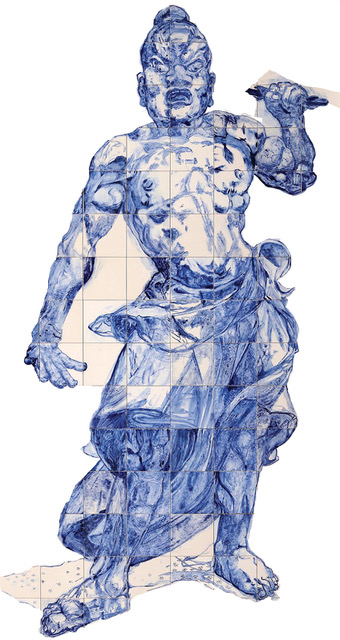 A NIOMON is a gate at the entrance to a Japanese temple area and houses two Japanese temple guards (Nio-zo): the Agyo-zo and UNgyo-zo. The sounds ‘A’ en ‘UN’ they represent are the first and last syllables of the Siddham script and together they represent all possible sounds and thus symbolise all knowledge, wisdom and compassion. Whoever walks through the gate and passes these guardians gains access to this wisdom.
A NIOMON is a gate at the entrance to a Japanese temple area and houses two Japanese temple guards (Nio-zo): the Agyo-zo and UNgyo-zo. The sounds ‘A’ en ‘UN’ they represent are the first and last syllables of the Siddham script and together they represent all possible sounds and thus symbolise all knowledge, wisdom and compassion. Whoever walks through the gate and passes these guardians gains access to this wisdom.PROJECT NIO-MON is a follow up on an art project called Issho-ni/ Tomo-ni, and is initiated by Dutch artist Jikke van Loon.
In 2015 she travelled to the former home town of two magnificant Japanese Temple Guardians, nowadays living in the National Museum of Amsterdam*. She went to say thank you to their former gate and home, the Niomon, that belonged to the Iwayaji area in Okuizumo cho, Shimane. This ‘Thank You’ resulted in a wider international art project of bringing home these Temple Guardians to their home town.
Although the Temple Guardians returned home it was impossible to place them in their former house, Iwaya-ji's Niōmon. The gate is in a terrible condition and needs repair/ rebuilding.
As a result, the inhabitants are still unable to walk 'the field of wisdom' and the temple guardians were not given the opportunity to regain their specific functionality: giving acces to and being guardians of the field of wisdom.
A foundation in both Japan and the Netherlands has been established to enable the creation of a gate, in both physical and non physical way, a Home for the returned Blue Temple Guardians.
*) In 2007 the Rijksmuseum in Amsterdam, The Netherlands, acquired two magnificent statues: 14th century wooden Japanese temple guardians that, for more than 700 years, stood in the temple gate (Niōmom) of the Iwaya-ji, a then prominent Buddhist temple in Shimane ken, Japan.
WHAT’S IN A NAMEWithin this project, three notions of MON (Gate-ness) play a combined role: gate (temple gate), platform and portal are an attempt to simultaneously designate one and the same entity in three different manifestations. We want to focus on the creation of these 'MON' and examine how functionality can be returned to the temple guardians. Again in coöperation with various institutes and participants in the Netherlands and Japan and the inhabitants of Yokota. We will focus on the notion of "gate-ness", using the original house of the two temple guards as a starting point to engage in workshops, Artist-in-Residence (AIR), exchanges and debates.
NIO refers to
1.) a ‘new’ (nio)- gate(mon)
2.) the house (niomon) of the new temple guards (Niōzo)
Further Reading:
Okuizumo Yokota
Shimane, door Radboud Molijn
Iwayaji Temple
Met Museum New York
Rijksmuseum of Amsterdam
NIO refers to
1.) a ‘new’ (nio)- gate(mon)
2.) the house (niomon) of the new temple guards (Niōzo)
Further Reading:
Okuizumo Yokota
Shimane, door Radboud Molijn
Iwayaji Temple
Met Museum New York
Rijksmuseum of Amsterdam
